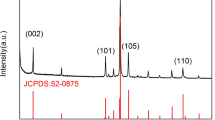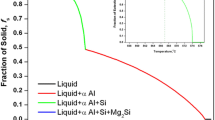Abstract
A direct 3D extrusion printing technique was used to produce Ti-TiB filaments and microlattices. The sintering properties of 3D ink extrusion and sintering of in situ Ti-TiB composite structures made from TiH2+TiB2 ink were investigated. The sintering kinetics of TiH2+TiB2 inks was studied during densification by pressureless sintering at 1050–1200 °C for 4–24 h in Ar. The linear shrinkage, grain size, microhardness, X-ray diffraction (XRD) patterns, and microstructural evolution of the Ti-TiB composite were studied. The sintering temperature had a more pronounced influence than the sintering time on the density of the Ti-TiB composite. There were two kinds of pores, irregular and spherical, caused by the Kirkendall effect and indiffusable gases. The TiB formed by in situ synthesis existed as either separated TiB whiskers (needle-like shapes) or clusters of TiB whiskers. The results of this work could be useful for controlling microporosity through incomplete sintering within filaments, especially for the production of in situ Ti-TiB with high volume fractions of TiB or other composites.
摘要
本文通过 3D 墨水打印方法制备 Ti-TiB 微点阵材料,研究 TiH2 +TiB2 墨水原位生成 Ti-TiB 复合材料的烧结性能。在 Ar 中分别进行 1050~1200 °C,4 h~24 h 的无压烧结,通过研究 Ti-TiB 复合材料的收缩率、晶粒尺寸、显微硬度、XRD 以及组织演变,研究了 TiH2 +TiB2 墨水在致密化过程中的烧结动力学。结果表明:烧结温度比烧结时间对 Ti-TiB 复合材料的致密度具有更显著的影响,由柯肯德尔效应和不可扩散的气体引起两类微孔形状,分别为不规则和球形;原位生成的 TiB 以分离的 TiB 晶须(针状)或 TiB 晶须簇的形式存在。本研究有助于微孔的设计与控制,也适合制备添加高体积分数 TiB的 Ti-TiB 复合材料或其他复合材料。
Similar content being viewed by others
References
WANG X, XU S, ZHOU S, XU W, LEARY M, CHOONG P, QIAN M, BRANDT M, XIE Y M. Topological design and additive manufacturing of porous metals for bone scaffolds and orthopaedic implants: A review [J]. Biomaterials, 2016, 83: 127–141. DOI: https://doi.org/10.1016/j.biomaterials.2016.01.012.
LI S, KIM Y, CHOI M, NAM T. Highly porous Ni-free Ti-based scaffolds with large recoverable strain for biomedical applications [J]. Intermetallics, 2020, 116: 106657. DOI: https://doi.org/10.1016/j.intermet.2019.106657.
JUNG H D. Fabrication of poly(lactic acid)/Ti composite scaffolds with enhanced mechanical properties and biocompatibility via fused filament fabrication (FFF)-based 3D printing [J]. Additive Manufacturing, 2019, 30: 100883. DOI: https://doi.org/10.1016/j.addma.2019.100883.
ATTAR H, EHTEMAM-HAGHIGHI S, SORO N, KENT D, DARGUSCH M S. Additive manufacturing of low-cost porous titanium-based composites for biomedical applications: Advantages, challenges and opinion for future development [J]. Journal of Alloys and Compounds, 2020, 827: 154263. DOI: https://doi.org/10.1016/j.jallcom.2020.154263.
LEE J, LEE H, CHEON K H, PARK C, JANG T S, KIM H E, JUNG H D. Fabrication of poly(lactic acid)/Ti composite scaffolds with enhanced mechanical properties and biocompatibility via fused filament fabrication (FFF)-based 3D printing [J]. Additive Manufacturing, 2019, 30: 100883. DOI: https://doi.org/10.1016/j.addma.2019.100883.
ERK K A, DUNAND D C, SHULL K R. Titanium with controllable pore fractions by thermoreversible gelcasting of TiH2 [J]. Acta Materialia, 2008, 56: 5147–5157. DOI: https://doi.org/10.1016/j.actamat.2008.06.035.
CAI C, HE S, LI L, TENG Q, SONG B, YAN C, WEI Q, SHI Y. In-situ TiB/Ti-6Al-4V composites with a tailored architecture produced by hot isostatic pressing: Microstructure evolution, enhanced tensile properties and strengthening mechanisms [J]. Composites Part B: Engineering, 2019, 164: 546–558. DOI: https://doi.org/10.1016/j.compositesb.2019.01.080.
SABAHI N, DILAWARY S A A, MOTALLEBZADEH A, SHAHEDI A M. Effect of TiB2 addition on the elevated temperature tribological behavior of spark plasma sintered Ti matrix composite [J]. Compos Part B: Eng, 2019, 172: 271–280. DOI: https://doi.org/10.1016/j.compositesb.2019.05.073.
HUANG L, AN Q, GENG L, WANG S, JIANG S, CUI X, ZHANG R, SUN F, JIAO Y, CHEN X, WANG C. Multiscale architecture and superior high-temperature performance of discontinuously reinforced titanium matrix composites [J]. Advanced Materials, 2020: 2000688. DOI: https://doi.org/10.1002/adma.202000688.
WANG X, XU S, ZHOU S, XU W, LEARY M, CHOONG P, QIAN M, BRANDT M, XIE Y M. Topological design and additive manufacturing of porous metals for bone scaffolds and orthopaedic implants: A review [J]. Biomaterials, 2016, 83: 127–141. DOI: https://doi.org/10.1016/j.biomaterials.2016.01.012.
MAKAU F M, MORSI K, GUDE N, ALVAREZ R, SUSSMAN M, MAY-NEWMAN K. Viability of titanium-titanium boride composite as a biomaterial [J]. ISRN Biomaterials, 2013: 970535. DOI: https://doi.org/10.5402/2013/970535.
ZHANG L, CHEN L. A review on biomedical titanium alloys: Recent progress and prospect [J]. Advanced Engineering Materials, 2019, 21: 21–29. DOI: https://doi.org/10.1002/adem.201801215.
BARI K, ARJUNAN A. Extra low interstitial titanium based fully porous morphological bone scaffolds manufactured using selective laser melting [J]. Journal of the Mechanical Behavior of Biomedical Materials, 2019, 95: 1–12. DOI: https://doi.org/10.1016/j.jmbbm.2019.03.025.
CUTOLO A, ENGELEN B, DESMET W, van HOOREWEDER B. Mechanical properties of diamond lattice Ti-6Al-4 V structures produced by laser powder bed fusion: On the effect of the load direction [J]. Journal of the Mechanical Behavior of Biomedical Materials, 2020, 104: 103656. DOI: https://doi.org/10.1016/j.jmbbm.2020.103656.
MA S, TANG Q, HAN X, FENG Q, SONG J, SETCHI R, LIU Y, LIU Y, GOULAS A, ENGSTRØM D S, TSE Y Y, ZHEN N. Manufacturability, mechanical properties, mass-transport properties and biocompatibility of triply periodic minimal surface (TPMS) porous scaffolds fabricated by selective laser melting [J]. Materials & Design, 2020, 195: 109034. DOI: https://doi.org/10.1016/j.matdes.2020.109034.
HU Y, CONG W, WANG X, LI Y, NING F, WANG H. Laser deposition-additive manufacturing of TiB-Ti composites with novel three-dimensional quasi-continuous network microstructure: Effects on strengthening and toughening [J]. Compos Part B, 2018, 133: 91–100. DOI: https://doi.org/10.1016/j.compositesb.2017.09.019.
ATTAR H, ZHANG L C, BONISCH M, CALIN M, SCUDINO S, ECKERT J. Selective laser melting of in situ titanium-titanium boride composites: Processing, microstructure and mechanical properties [J]. Acta Materialia, 2014, 76: 13–22. DOI: https://doi.org/10.1016/j.actamat.2014.05.022.
HAYAT M D, SINGH H, HE Z, CAO P. Titanium metal matrix composites: An overview [J]. Composites Part A: Applied Science and Manufacturing, 2019, 121: 418–438. DOI: https://doi.org/10.1016/j.compositesa.2019.04.005.
AZARMI F, SEVOSTIANOV I. Evaluation of the residual stresses in metallic materials produced by additive manufacturing technology: Effect of microstructure [J]. Current Opinion in Chemical Engineering, 2020, 28: 21–27. DOI: https://doi.org/10.1016/j.coche.2019.12.004.
ZHOU Z, LIU Y, LIU X, ZHAN Q, WANG K. Microstructure evolution and mechanical properties of in-situ Ti6Al4V-TiB composites manufactured by selective laser melting [J]. Composites Part B: Engineering, 2021, 207: 108567. DOI: https://doi.org/10.1016/j.compositesb.2020.108567.
KOURAYTEM N, LI X, TAN W, KAPPES B, SPEAR A. Modeling process-structure-property relationships in metal additive manufacturing: A review on physics-driven versus data-driven approaches [J]. Journal of Physics: Materials, 2020. DOI: https://doi.org/10.1088/2515-7639/abca7b.
CHEN P, KENEL C, WANG Y, DUNAND D C. SnO2-Ag composites with high thermal cycling stability created by Ag infiltration of 3D ink-extruded SnO2 microlattices [J]. Applied Materials Today, 2020, 21: 100794. DOI: https://doi.org/10.1016/j.apmt.2020.100794.
KARAKURT I, LIN L. 3D printing technologies: Techniques, materials, and post-processing [J]. Current Opinion in Chemical Engineering, 2020, 28: 134–143. DOI: https://doi.org/10.1016/j.coche.2020.04.001.
KENEL C, CASATI N P M, DUNAND D C. 3D ink-extrusion additive manufacturing of CoCrFeNi high-entropy alloy micro-lattices [J]. Nature Communications, 2019, 10: 1–8. DOI: https://doi.org/10.1038/s41467-019-08763-4.
TAYLOR S L, SHAH R N, DUNAND D C. Ni-Mn-Ga micro-trusses via sintering of 3D-printed inks containing elemental powders [J]. Acta Materialia, 2018, 143: 20–29. DOI: https://doi.org/10.1016/j.actamat.2017.10.002.
GEISENDORFER N R, SHAH R N. Effect of polymer binder on the synthesis and properties of 3D-printable particle-based liquid materials and resulting structures [J]. ACS Omega, 2019, 4: 12088–12097. DOI: https://doi.org/10.1021/acsomega.9b00090.
HIRT L, REISER A, SPOLENAK R, ZAMBELLI T. Additive manufacturing of metal structures at the micrometer scale [J]. Adv Mater, 2017, 29: 1604211. DOI: https://doi.org/10.1002/adma.201604211.
ELSAYED H, NOVAK N, VESENJAK M, ZANINI F, CARMIGNATO S, BIASETTO L. The effect of strut size on microstructure and compressive strength of porous Ti6Al4V lattices printed via direct ink writing [J]. Materials Science and Engineering A, 2020, 787: 139484. DOI: https://doi.org/10.1016/j.msea.2020.139484.
PASCU C I, GINGU O, ROTARU P, VIDA-SIMITI I, HARABOR A, LUPU N. Bulk titanium for structural and biomedical applications obtaining by spark plasma sintering (SPS) from titanium hydride powder [J]. Journal of Thermal Analysis and Calorimetry, 2013, 113: 849–857. DOI: https://doi.org/10.1007/s10973-012-2824-2.
JIMOH A, SIGALAS I, HERMANN M. Synthesis of titanium matrix composite (Ti-TiB-TiC) through sintering of TiH2-B4C [J]. Materials Sciences and Applications, 2012, 3: 30–35. DOI: https://doi.org/10.4236/msa.2012.31005.
YAN M, DARGUSCH M S, KONG C, KIMPTON J A, KOHARA S, BRANDT M, QIAN M. In situ synchrotron radiation study of TiH2-6Al-4V and Ti-6Al-4V: Accelerated alloying and phase transformation, and formation of an oxygen-enriched Ti4Fe2O phase in TiH2-6Al-4V [J]. Metallurgical and Materials Transactions A, 2015, 46: 41–45. DOI: https://doi.org/10.1007/s11661-014-2631-4.
SONG Bin-na, CHRISTOPH K, DAVID C, DUNAND. 3D ink-extrusion printing and sintering of Ti, Ti-TiB, Ti-TiC microlattices [J]. Additive Manufacturing, 2020, 35: 101412. DOI: https://doi.org/10.1016/j.addma.2020.101412.
CHEN I W, WANG X H. Sintering dense nanocrystalline ceramics without finalstage grain growth [J]. Nature, 2000, 404(6774): 168–171. DOI: https://doi.org/10.1038/35004548.
ABDELJAWAD F, BOLINTINEANU D S, COOK A, BROWN-SHAKLEE H, DIANTONIO C, KAMMLER D, ROACH A. Sintering processes in direct ink write additive manufacturing: A mesoscopic modeling approach [J]. Acta Materialia, 2019, 169: 60–75. DOI: https://doi.org/10.1016/j.actamat.2019.01.011
LIMBERG W, EBEL T, PYCZAK F, OEHRING M, SCHIMANSKY F P. Influence of the sintering atmosphere on the tensile properties of MIM-processed Ti45Al5Nb0.2B0.2C [J]. Materials Science and Engineering A, 2012, 552: 323–329. DOI: https://doi.org/10.1016/j.msea.2012.05.047.
LUO S D, LIU B, TIAN J, QIAN M. Sintering of titanium in argon and vacuum: Pore evolution and mechanical properties [J]. International Journal of Refractory Metals and Hard Materials, 2020, 90: 105226. DOI: https://doi.org/10.1016/j.ijrmhm.2020.105226.
BANERJEE S, JOENS C J. Sintering powder metal injection molded (MIM) titanium alloys: In vacuum or argon? [J]. Key Eng Mater, 2016, 704: 113–117. DOI: https://doi.org/10.4028/www.scientific.net/KEM.704.113.
OH J M, KOO J G, LIM J W. Variation in lattice parameters and strain of sintered titanium powder by advanced hydrogen sintering process [J]. Powder Technology, 2018, 330: 27–31. DOI: https://doi.org/10.1016/j.powtec.2018.02.018.
BHOSLE V, BABURAJ E G, MIRANOVA M, SALAMA K. Dehydrogenation of TiH2 [J]. Materials Science and Engineering A, 2003, 356: 190–199. DOI: https://doi.org/10.1016/s0921-5093(03)00117-5.
GEMELLI E, de JESUS J, CAMARGO N H A, de ALMEIDA SOARES G D, HENRIQUES V A R, NERY F. Microstructural study of a titanium-based biocomposite produced by the powder metallurgy process with TiH2 and nanometric β-TCP powders [J]. Materials Science and Engineering C, 2012, 32: 1011–1015. DOI: https://doi.org/10.1016/j.msec.2012.02.017.
MOHAMMADZADEH, AZADBEH M, DANNINGER H, SABAHI NAMINI A. Ti-TiB2 composites consolidated by spark plasma sintering: Reaction mechanism, characteristics of in-situ formed phases and densification behavior [J]. Mater Chem Phys, 2020, 242: 122556. DOI: https://doi.org/10.1016/j.matchemphys.2019.122556.
ERIKSSON M, SALAMON D, NYGREN M, SHEN Z. Spark plasma sintering and deformation of Ti-TiB2 composites [J]. Materials Science and Engineering A, 2008, 475: 101–104. DOI: https://doi.org/10.1016/j.msea.2007.01.161.
PANDA K B, CHANDRAN K S R. Synthesis of ductile titanium-titanium boride (Ti-TiB) composites with a beta-titanium matrix: The nature of TiB formation and composite properties [J]. Metall Mater Trans, 2003, 34: 1371–1385. DOI: https://doi.org/10.1007/s11661-003-0249-z.
SONG Y, DONG S, STASIUK O, SAVVAKIN D, IVASISHIN O. Synthesis of Ti/TiB composites via hydrogen-assisted blended elemental powder metallurgy [J]. Front Mater, 2020, 7: 572005. DOI: https://doi.org/10.3389/fmats.2020.572005.
SCHUMANN E, SILVAIN J F, BOBET J L, BARDET M, LU Y, KOTOUSOV A, LAMIRAND-MAJIMEL M. The effects of ball milling and the addition of blended elemental aluminium on the densification of TiH2 power [J]. Materials Chemistry and Physics, 2016, 173: 106–116. DOI: https://doi.org/10.1016/j.matchemphys.2016.01.045.
GERMAN R M. Powder metallurgy science [M]. 2nd ed. Princeton, NJ: Metal Powder Industries Federation, 1994: 244–385.
PENG Q, YANG B, FRIEDRICH B. Porous titanium parts fabricated by sintering of TiH2 and Ti powder mixtures [J]. J of Materi Eng and Perform, 2018, 27: 228–242. DOI: https://doi.org/10.1007/s11665-017-3099-3.
COBLE R L. Sintering crystalline solids. I. Intermediate and final state diffusion models [J]. Journal of Applied Physics. 1961, 32: 787–792. DOI: https://doi.org/10.1063/1.1736107.
COBLE R L. Sintering crystalline solids. II. Experimental test of diffusion models in powder compacts [J]. Journal of Applied Physics, 1961, 32: 793–799. DOI: https://doi.org/10.1063/1.1736108.
DLAPKA M, DANNINGER H, GIERL C, LINDQVIST B. Defining the pores in PM components [J]. Metal Powder Report, 2010, 65: 30–33. DOI: https://doi.org/10.1016/S0026-0657(10)70093-X.
Acknowledgments
SONG Bin-na thanks Dr. Christoph KENEL and Prof. David C. DUNAND for providing access to experimental setups at Northwestern University and useful discussion and input.
Author information
Authors and Affiliations
Contributions
SONG Bin-na provided the concept, funding acquisition, wrote, reviewed, edited the draft of manuscript. CAO Jian edited the draft of manuscript.
Corresponding author
Additional information
Conflict of interest
SONG Bin-na and CAO Jian declare that they have no conflict of interest.
Foundation item: Project(201806920003) supported by the China Scholarship Council; Project(172180) supported by the Swiss National Science Foundation; Projects(ECCS-1542205, DMR-1720139) supported by the National Natural Science Foundation, USA
Rights and permissions
About this article
Cite this article
Song, Bn., Cao, J. Sintering properties of in situ Ti-TiB microlattices created by 3D extrusion printing of TiH2+TiB2 inks. J. Cent. South Univ. 28, 1078–1088 (2021). https://doi.org/10.1007/s11771-021-4681-2
Received:
Accepted:
Published:
Issue Date:
DOI: https://doi.org/10.1007/s11771-021-4681-2




